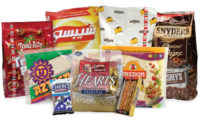Integrating sustainable packaging for on-the-go snacks
Closing and bagging product introductions feature a wide range of features.
















Sustainability initiatives are driving innovation in closing and bagging equipment, such as baggers, closers, twist ties, clips, zippers, resealable closures, heat sealing and ultrasonic sealing. As consumers become more eco-conscious, there is a strong demand to use packaging materials that are compostable, biodegradable, light-weighted, recyclable or made with recycled materials.
According to the “Packaging Sustainability: A Changing Landscape” report from PMMI, Herndon, VA, advances in closing and bagging equipment include broader machine tolerances as sustainable materials use more post-consumer recycled content. This equipment also needs to handle a wider variety of materials such as reduced material weight and mono-materials. Bakery and snack producers must consider temperature tolerances and seal integrity when looking at using more sustainable materials, the report notes.
Syntegon, New Richmond, WI, a manufacturer of continuous-motion, pre-made bag and pouch sealing machines, strives to meet sustainability initiatives by focusing on how to best seal new substrates. “We work with bag suppliers as new heat-sealable paper products are introduced to the market. This means that pull-testing seals, seal appearance evaluation, and temperature and production speeds are constantly reviewed. We work with the entire baking industry to offer new technology and information resources,” says Jim Miller, product sales manager.
To meet sustainability demands, Bedford Industries, Worthington, MN, which produces twist ties for bag closure of bread and other bakery items, provides closing and bagging solutions that use less plastic or may be recycled. Through its TagBack initiative, the company invites consumers to return ties and tags to its manufacturing facility to be properly recycled. “We’ve collected 40,000 pounds of returned ties and tags, which have been separated and up-cycled into other usable materials,” says Beth Radloff, marketing specialist.
One trend that has remained strong over the past year is the push toward healthy bakery and snack choices, which has resulted in the proliferation of on-the-go, single-serving packets. Vertical form/fill/seal machines offer a good solution for filling these packets. The key to making a successful seal for these types of pouches is allowing for enough dwell time, according to Christine Duncan, marketing manager, Flexibles for Matrix Packaging Machinery, a ProMach brand, Saukville, WI.
“A good example is the Matrix Morpheus vertical form/fill/seal machine,” Duncan notes. “The Morpheus uses a continuous-motion, high-speed jaw system, which cuts the film and provides just enough dwell time for the three pouch seams to seal properly, all while the film is in motion. This allows the Morpheus to run films that typically require a higher dwell time, such as polyethylene.” The machine can reach output speeds of 180 pouches per minute.
New systems
A wide range of closing and bagging equipment has been introduced to the bakery and snack market over the past year. For example, TNA Solutions, New South Wales, Australia, which provides integrated conveying, weighing and packaging equipment to the bakery and snack market, recently introduced the tna robag FX 3ci, which can process 250 bags per minute. “Its streamlined design, minimal machine footprint and intelligent operating system keeps waste levels as low as 0.1 percent, resulting in a more efficient, sustainable and profitable packaging solutions,” says Anurag Mitra, product marketing manager, Packaging. The machine can accommodate a wide range of jaw types to handle many bag sizes and formats, and it allows seamless switching between different pack sizes.
All Packaging Machinery, Ronkonkoma, NY, customizes its machines to fit the customer’s specific bag or pouch. Options are added to enhance ergonomics and throughput, depending on quantify and type of bag. “In some cases, a bag loader, which would have been used in a horizontal position, works best in a vertical position. Frozen bread loaves can be loaded into a bag and then sealed on our vertical band sealer. Flat breads or tortillas can be loaded in the horizontal position bagger and sealed on our horizontal band sealer,” says Lynn Miranda, sales and marketing manager.
Formost Fuji, Woodinville, WA, a manufacturer of horizontal bagging and wrapping machines, offers the Formost Fuji Bagger, which can operate at up to 90 ppm while providing gentle product handling. “With several infeed and discharge conveyor options available, our engineering department can design a bagging system to fit within line restrictions. Our inline bun system eliminates 90º transfers, saving space and increasing output speeds,” says Angela McDaniel, marketing coordinator.
Miller says that re-closable pouches and bags are in high demand. To meet that need, Syntegon equipment can run zipper bags, slider bags, and gusseted and dual material laminates. “Our Wisconsin factory has a lab dedicated to bag testing,” he notes.
Kwik Lok Corp., Yakima, WA, offers the 910 automatic bag closing machine, which handles various plastic thicknesses, and a wide range of package types, weights and sizes. Closures can be printed with price, date and/or code information. Available colors vary with plastic thickness: .030-inch–seven colors, .045-inch–three colors. Kwik Lok also offers the 909 tamper-evident machine, which uses laser-stitch technology to stitch the bag together, so consumers can easily tell if the bag has been tampered with. Once opened, the bag can be reclosed via a sustainable Eco-Lok closure.
Burford Corp., Maysville, OK, a manufacturer of Twist Tie equipment, has introduced a Tape Closure System that produces a reclosable, printable, metal-detection-friendly closure as well as a tamper-evident component. It can produce 70 closures per minute. The company also has introduced a Tamper Evident Sealing system, which provides a seal and perforation at the tail of the package. “We recommend pairing the Tamper Evident Sealer with a Twist Tyer to provide a way for consumers to easily reclose the package,” says Josh Hughes, sales manager.
Bedford Industries offers semi-automatic machines that can apply re-closures at speeds of up to 30 bags per minute. The closures can be applied to plastic or paper bags. “We offer tabletop units or small machines, making application more convenient,” says Beth Radloff, marketing specialist. The company plans to release an updated version of its Mini Tyer later this year.
Ultrasonic sealing
The latest ultrasonic sealing technology can help bakery and snack producers preserve freshness and achieve sustainability goals, according to Maria Ferrente, senior director, marketing and communications for PMMI. “With the growing demand to utilize more sustainable and recyclable films, such as paper-based materials, ultrasonic sealing technology has several benefits to offer because it doesn’t add heat from the outside, but only generates the required melting temperature in the sealant layer. Also, ultrasonic sealing reduces the amount of energy consumed and increases overall equipment effectiveness, because no warm-up is required.”
Herrmann Ultrasonics, Bartlett, IL, manufactures ultrasonic sealing modules for use in vertical and horizontal form/fill/seal equipment. “Our LSM Fin Longitudinal Seal Module can be used on horizontal flow wrappers to form a continuous back seal without the use of heat,” says Ken Hundley, internal account manager, packaging. “Ultrasonic vibrations cause the sealant layer to melt and bond without transmitting any residual heat to the product. Because it is a vibration-based seal, any product residue in the seal area is moved out of the way during the process.”
Hundley says the company’s TSM Top-Seal Module is suitable for stand-up pouches and can be installed on rotary-style form/fill/seal systems, as well as on horizontal inline pouching units. “The closed-loop feedback system in our sealing modules can validate a good or bad seal, and provide a signal that a particular pouch does not meet specification,” he notes.
What near-future advances in closing and bagging equipment are on the horizon? Mitra of TNA Solutions foresees a leap forward in smart packaging solutions. “Connected systems powered by The Internet of Things were already trending prior to the COVID-19 crisis. Producers are now more aware of the opportunities these technologies present–particularly in terms of continuous monitoring and quick error detection and resolution. Going forward, the potential for intelligent technology to improve closing and bagging speeds and reduce waste will be put to use more widely across the bakery and snack sector.”
Looking for a reprint of this article?
From high-res PDFs to custom plaques, order your copy today!













